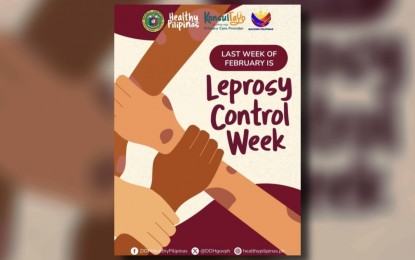
CURABLE. The Department of Health designates the last week of February as Leprosy Control Week. In Ilocos Region, there are 132 leprosy cases as of December 2023. (Photo courtesy of DOH-CHD-1)
MALASIQUI, Pangasinan – A heath official in the Ilocos Region urged the public to be kinder on people with leprosy since the disease is curable and recovery rate is high if patients follow the treatment cycle.
In a forum hosted by the Philippine Information Agency-Ilocos Region on Friday, Department of Health-Center for Health-Ilocos Region (DOH-CHD-1) medical officer Dr. Rheuel Bobis said the prevalence rate of the disease in the region is 0.25 percent, way below the 1 percent rate in the national level.
As of end-2023, there are 132 cases in the region -- 93 of which are in Pangasinan, 15 in Ilocos Norte, 19 in Ilocos Sur, and five in La Union
The DOH is encouraging village health workers and family members to ensure the patients complete their treatment, Bobis said.
The treatment lasts within six months to a year.
Leprosy, also called Hansen's disease because of its discovery by Norwegian physician Dr. Gerhard Armauer Hansen in 1874, is an infection caused by the slow-growing bacteria called Mycobacterium leprae.
It affects the nerves, skin, eyes, and lining of the nose.
"We need to remove the stigma and extend understanding to the patients. Leprosy patients are oppressed and avoided and they have the tendency to withdraw. If this happens, they would not be able to avail of the services intended for their treatment," he said.
Bobis said leprosy can be transferred not merely by skin-to-skin contact or exposure to a patient but through respiratory droplets if there is a long and constant exposure to the untreated patients.
"It is not highly infectious as 97 percent of the world's population has immunity to its bacteria," he said.
He said rural health units, city health offices, and other government health centers provide free multi-drug therapy medicines to the patients.
"There is a cure to it although it takes time. But after the cycle is finished, we can be sure that the bacteria causing it is dead," he said. (PNA)
